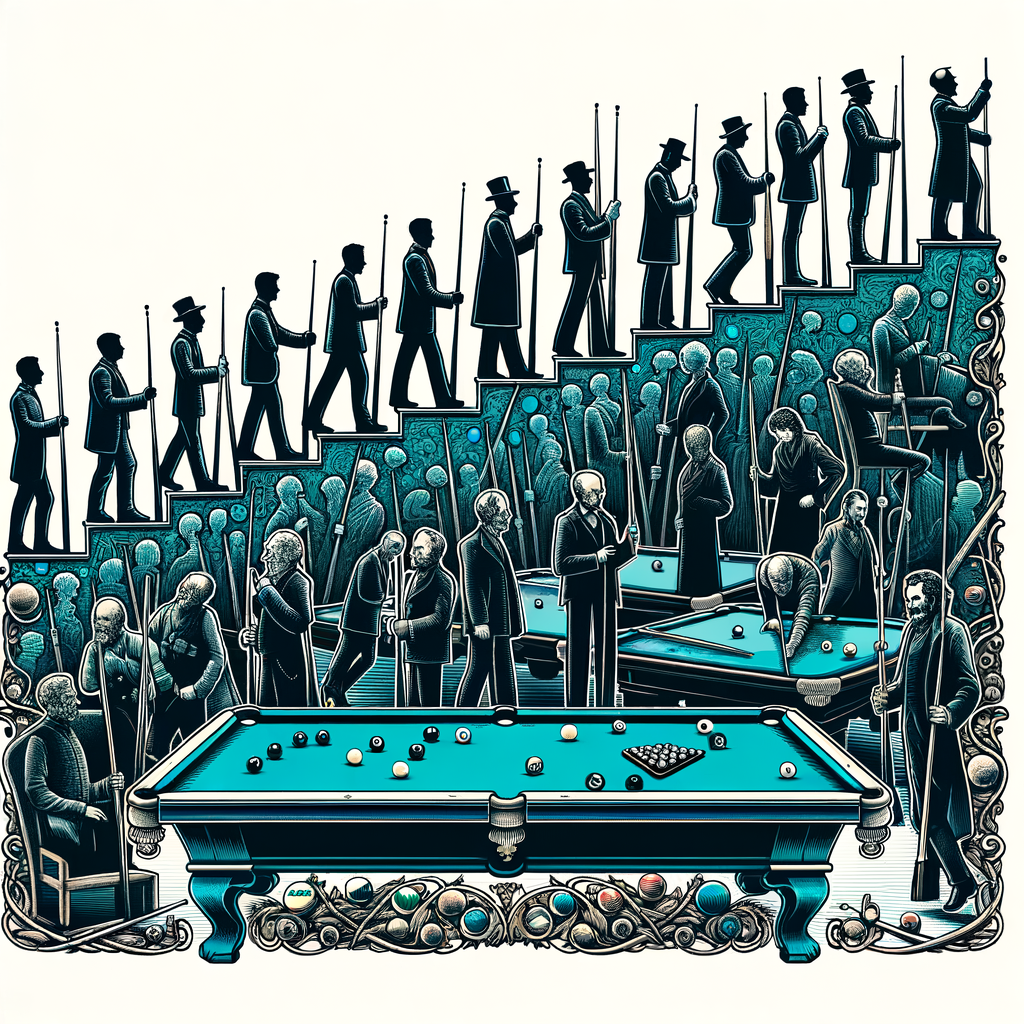
Introduction to Billiards History
Welcome to the fascinating world of billiards! This popular game has a rich and intriguing history that spans centuries. Let’s dive into the captivating journey of billiards and understand why studying its history is significant.
-
- Overview of the History of Billiards
Billiards, also known as cue sports, has been a beloved pastime for centuries. The game originated in the 15th century in Europe, initially played by the nobility in large, open-air courts. Over time, the game evolved and moved indoors, with the table becoming its new field. The game we know today, with its green cloth-covered table and balls, took shape in the 19th century.
Billiards has been more than just a game. It has been a social glue, bringing people together across different classes and cultures. It has also been a platform for innovation, leading to the development of new materials and technologies. For instance, the invention of the leather cue tip in the 1820s revolutionized the game, allowing players to add spin to the ball.
-
- Significance of Studying Billiards History
Understanding the history of billiards gives us a unique perspective on society and culture. The game’s evolution reflects changes in social norms, technology, and even politics. For example, the transition from outdoor to indoor play mirrored societal shifts from rural to urban living.
Studying billiards history also enriches our appreciation of the game. It helps us understand the skill and strategy involved, and the significance of the rules. It reminds us that every shot we make, every game we play, is part of a long and storied tradition.
So, let’s embark on this exciting journey through the annals of billiards history, from its royal beginnings to its modern-day popularity. As we delve deeper into the past, we will discover how this simple game has left an indelible mark on our world.
The Dawn of Cue Sports: Historical Billiards
As we delve into the history of cue sports, we find ourselves at the dawn of billiards. This game, which has evolved over centuries, has a rich and fascinating history.
Origins and Early Development
The origins of billiards can be traced back to the 15th century. It began as a lawn game similar to croquet, played by the nobility in Northern Europe. With time, the game moved indoors and evolved into the version we know today.
-
- Billiards in the 15th Century
The game of billiards was first recorded in the 15th century. It was initially played on a table with a simple border, and the balls were pushed, not struck, with wooden sticks called ‘maces’. The term ‘billiard’ is believed to have originated from the French word ‘billart’, meaning ‘mace’, or ‘billiart’, meaning ‘ball’.
-
- Evolution of Billiards in the 16th and 17th Centuries
During the 16th and 17th centuries, the game underwent significant changes. The mace was replaced by the ‘cue’, a stick with a narrow end for striking the ball. The table’s simple border evolved into a more complex one with pockets. These changes marked the transition from the primitive form of billiards to the modern game we know today.
In the next section, we will explore key figures and events that shaped the history of billiards.
Historical Dive into Billiards: Key Figures and Events
As we delve into the rich history of billiards, we encounter several key figures and events that shaped the game we know today. Let’s explore these in more detail.
-
- Notable figures in early billiards history
One of the earliest known figures in billiards history is King Louis XI of France. He was the first known monarch to own a billiard table in the 15th century. Another key figure is Henry VIII of England, who was known for his love of the game. In the 19th century, Michael Phelan, an Irish-born American, was a leading player and promoter of the game. He is often called the “father of American billiards”.
-
- Major events and turning points
The history of billiards is marked by several major events and turning points. The invention of the cue stick in the 16th century was a significant development. Before this, players used a mace, which was less precise. Another turning point was the introduction of standardized rules in the 19th century by Michael Phelan. The first World Snooker Championship in 1927 marked the beginning of professional play.
These figures and events played a crucial role in shaping billiards into the popular sport it is today. From the royal courts of Europe to the modern professional arenas, the game of billiards has a rich and fascinating history.
| Key Figure | Contribution |
|---|---|
| King Louis XI | First known monarch to own a billiard table |
| Henry VIII | Popularized the game in England |
| Michael Phelan | Standardized rules, promoted the game in America |
| Major Event | Impact |
|---|---|
| Invention of the cue stick | Improved precision in play |
| Introduction of standardized rules | Made the game more fair and competitive |
| First World Snooker Championship | Marked the beginning of professional play |
Billiards Evolution: From Royalty to the Masses
Billiards, a game once exclusively played by the elite, has evolved over centuries to become a popular pastime for people of all classes. Let’s delve into this fascinating journey.
The Spread of Billiards in the 18th and 19th Centuries
During the 18th and 19th centuries, billiards began to spread beyond the confines of the aristocracy and into the public sphere. This period marked a significant shift in the game’s accessibility and popularity.
-
- Billiards as a Game of the Aristocracy
In the early days, billiards was a game reserved for the upper classes. It was often seen as a symbol of status and sophistication. The game was played in luxurious billiard rooms in grand mansions and palaces. The tables, often made of expensive woods and adorned with intricate carvings, were as much a piece of art as they were a gaming platform.
-
- Billiards Becomes a Popular Public Pastime
However, as the 19th century progressed, billiards began to shed its image as a game solely for the aristocracy. Billiard halls started to appear in towns and cities, making the game accessible to the masses. These public spaces provided a place for people to socialize, compete, and enjoy the game. By the end of the 19th century, billiards had become a popular public pastime, enjoyed by people from all walks of life.
Thus, the 18th and 19th centuries marked a significant period in the history of billiards, transforming it from a game of the elite to a beloved pastime for many.
Technological Advances and Their Impact on Billiards
As we delve into the evolution of billiards, it’s impossible to overlook the role of technology. Technological advancements have significantly shaped the game, introducing new materials and designs, and influencing gameplay and strategy. Let’s explore these changes in more detail.
- Introduction of New Materials and Designs
In the early days, billiard balls were made from ivory. However, the scarcity of ivory and the need for a more sustainable option led to the introduction of synthetic materials. Today, most billiard balls are made from phenolic resin, a material that offers superior durability and playability. The cues, initially made from wood, have also seen a shift towards graphite and fiberglass for better precision and longevity.
Table designs have evolved too. The traditional rectangular shape has remained, but the materials used for the bed and the cushions have changed. Slate has become the preferred choice for the bed due to its flatness and stability, while cushions have moved from rubber to synthetic materials for better bounce.
- Effects on Gameplay and Strategy
These technological advancements have not just changed the look and feel of the game, but also how it’s played. The introduction of new materials has led to more consistent and predictable ball behavior. This has allowed players to develop more advanced strategies, focusing on precision and control rather than power.
For instance, the use of synthetic materials for balls and cushions has reduced the amount of “throw” – the deviation of the ball’s path due to friction with the cushion. This has made the game more predictable, enabling players to plan their shots with greater accuracy.
Moreover, the durability of the new materials ensures that the equipment maintains its quality over time. This means that players can rely on consistent performance from their gear, allowing them to focus more on improving their skills and strategies.
In conclusion, technological advancements have not only made billiards more accessible but also more strategic and exciting. As technology continues to evolve, who knows what the future holds for this beloved game?
Modern Era: Cue Sports Chronicles
As we delve into the modern era, we witness a significant shift in the world of cue sports. The 20th century was a pivotal time for billiards, marking its transition from a casual pastime to a professional sport.
Billiards in the 20th Century
The 20th century brought about a new era for billiards, with the rise of professional players and the establishment of key tournaments. Let’s explore these developments in detail.
-
The Rise of Professional Billiards
At the dawn of the 20th century, billiards started to gain recognition as a professional sport. The establishment of professional leagues and associations played a crucial role in this development. Players began to train rigorously, dedicating their lives to mastering the game. The sport’s popularity soared, attracting audiences worldwide.
One notable figure in this era was Willie Hoppe, a professional carom billiards player. He dominated the sport for several decades, setting numerous records and becoming a household name. His success story is a testament to the rise of professional billiards during this period.
-
Key Tournaments and Champions
As the sport grew in popularity, several key tournaments were established. These competitions became platforms for players to showcase their skills and vie for the title of champion. Some of the most prestigious tournaments of the 20th century include the World Professional Billiards Championship and the U.S. Open 9-Ball Championships.
These tournaments have produced many champions who have left their mark on the sport. Players like Willie Mosconi, who won the World Straight Pool Championship an astounding 19 times, and Joe Davis, who dominated the World Professional Billiards Championship for two decades, are just a few examples of the exceptional talent that emerged during this era.
In conclusion, the 20th century was a transformative period for billiards. The rise of professional billiards and the establishment of key tournaments have shaped the sport as we know it today. These developments have paved the way for the current state of billiards, which we will explore in the next section.
The Current State of Billiards: 21st Century and Beyond
As we journey into the 21st century and beyond, the game of billiards continues to evolve. This section will explore the modern challenges and opportunities for billiards and the future prospects for the sport.
-
- Modern challenges and opportunities for billiards
Billiards, like any other sport, faces its own set of challenges in the modern era. The rise of digital entertainment and the increasing popularity of e-sports have posed significant competition. However, it’s not all doom and gloom. The digital age also presents a plethora of opportunities. The advent of online platforms has made it possible for billiards enthusiasts to play and compete from the comfort of their homes. This has not only increased accessibility but also broadened the game’s reach, attracting a new generation of players.
-
- Future prospects for the sport
Looking ahead, the future of billiards seems promising. The sport’s governing bodies are making concerted efforts to promote the game, especially among the youth. There is a growing emphasis on professional training and development, which is expected to elevate the standard of play. Furthermore, the potential inclusion of billiards in the Olympic Games is a significant development that could boost the sport’s global profile.
In conclusion, while billiards faces some challenges in the 21st century, the sport is also presented with numerous opportunities. With strategic planning and effective promotion, billiards can continue to thrive and attract new enthusiasts in the years to come.
Conclusion: Reflecting on the History of Cue Sports
As we come to the end of our journey through the history of cue sports, we can reflect on the key takeaways and what the past tells us about the future of billiards. The game has evolved significantly over the centuries, from a pastime of royalty to a sport enjoyed by the masses. Let’s summarize the key points we’ve learned and look ahead to the future of this fascinating sport.
-
- Key takeaways from billiards history
Billiards began as a game for the elite, with its roots in 15th-century Europe. It evolved over time, with significant changes in the 19th and 20th centuries, such as the introduction of standardized rules and equipment. The sport has always been a reflection of the times, with its popularity and evolution often mirroring societal changes.
-
- What the past tells us about the future of billiards
The history of billiards suggests that the sport will continue to evolve and adapt to the times. With the rise of technology, we can expect further changes in the way the game is played and viewed. The popularity of billiards has endured through centuries, and it is likely to remain a beloved sport for many more years to come.
In conclusion, the history of cue sports is a rich and fascinating journey. It’s a testament to the enduring appeal of the game, and a reminder of its capacity to evolve and adapt. As we look to the future, we can expect to see further changes and innovations, but the essence of the game – the skill, strategy, and thrill of the play – will undoubtedly remain the same.














